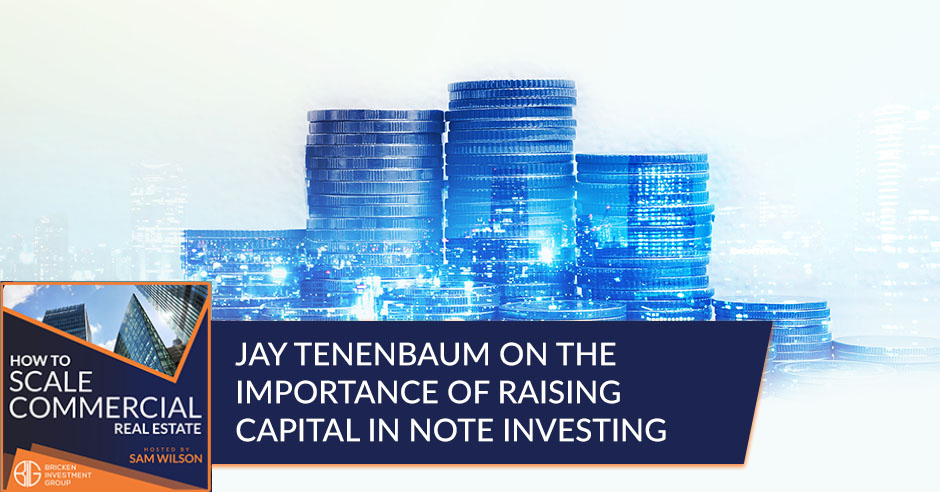When it comes to buying notes, raising capital is key. Remember, there is no bank on the notes side of things. Learn more about raising capital with your host Sam Wilson and his guest Jay Tenenbaum. As a former debt collector, Jay went into mortgage notes and has acquired over 450 distressed mortgage notes and real property in more than 30 states. He is also the Co-Founder of Scottsdale Real Estate Investments. Join Sam and Jay to learn more about the note industry today!
—
Watch the episode here:
Listen to the podcast here:
Jay Tenenbaum On The Importance Of Raising Capital In Note Investing
Jay Tenenbaum has acquired over 450 distressed mortgage notes and real property in more than 30 states. He attributes his success and expertise to his ability to effectively integrate twenty years of experience as a former debt collection professional.
—
Jay, welcome to the show.
Thank you so much for having me.
It is a pleasure to have you on. I’m excited to jump in, twenty years of experience as a former debt collection professional if I could get the words out of my mouth in one whole sentence there. Tell us quickly. There are three questions I ask every guest who comes to the show. Where did you start? Where are you now? How did you get there?
I grew up in Colorado. My father owned restaurants and my mom owned a catering service. I thought that is what I would do in life, to follow their stuff. I was a busboy, waiter, bartender, that style and life. One night, my father and I were having dinner by ourselves, which was a very rare occurrence anyway, like a pink unicorn. He says, “Get out of this business. Go get a profession.”
Medicine did not interest me, but the law did. I hightailed it off to law school in California and stayed. I married my wife, and we had a debt collection law practice for twenty years in California. I got out of business in 2008 and 2009. In 2012, we were investing and buying judgment liens in California, not hitting banks or garnishing wages anymore. We were just re-executing on real property.
In 2013, I got an opportunity. A friend of mine sent me an email that this guy had this note buying for a dummies workshop in San Diego. For four days, I looked at it and went down there. I’m like, “I could do this.” I have been in debt all my life. It’s not ever personally. The key to how I got started investing in distressed mortgages, as I wanted to be a real estate investor like everybody else, post-crash, etc. was to go to the hotel ballrooms and all that stuff. Come Monday morning, my challenge was always, “Where am I going to find a deal?”
In this workshop, he introduced us to different hedge fund sources as part of the workshop. I had sourcing right away. I built those relationships over the course of time. Essentially, I’m lazy. I don’t like to hunt. I get deals brought to me on spreadsheets on a regular basis. That’s what’s enabled me to do over 450 deals since 2013.
That’s a lot of fun. It’s rare that you go to a four-day seminar or something like that, and I hate to say that there are a lot of gurus out there teaching nonsense. You got to go to a seminar. There was actionable information and here are some real people you can plugin with.
The four days were a great opportunity like anything else. As he mixed in relationships building, I did sign up for his mastermind and mentoring program, which was fantastic. He is still a good friend to this day and he is my mentor. The information was good. I have done this business for quite a while now. Certainly, I have stubbed my toe along the way and ripped the band-aid off. To set the landscape, you couldn’t jump out. It was my experience. I wasn’t capable after four days go, “I can do this.”
The mentoring and the mastermind did help as well. It helped me in a lot of different areas. Interestingly, not only did they have relationships with the people that I met while I was there, but part of the package was his Rolodex of other banks and hedge fund contacts, which I never use. I started cultivating relationships. My takeaway in the mastermind and the mentoring side is eight weeks of mentoring and weekly calls. It was putting together your perspectives or business plans, things like that, to help you raise capital. On the note side, no bank you would go to get your 90% leverage. Raising capital has been integral, which enabled me to be successful as I have.

Tell me about the things you like about your business right now. What about it appeals to you? Why does it make sense?
First of all, I cut my teeth are buying low-value assets. Houses in the Midwest and South were worth $50,000, $60,000, or $70,000. You’re buying them back then $10,000, $15,000, or $20,000. It was easy to get a borrower to keep them in their home, do a loan line and work something. Your rate of return in buying that low-value stuff is phenomenal. The satisfaction of keeping a borrower in their home, generating cashflow and wealth legacy to our investors was the initial why.
We scaled from there and we were buying higher-value assets. As an opportunistic acquisition source, we’re getting paid off a lot at auction in 2021. The stuff we take back, we’re flipping because now the price points aren’t conducive. We do some rentals out of it, but mostly, when you’re buying an asset for $350,000, the houses were $600,000 to $700,000. It doesn’t make sense to do as a rental or keep your client there.
That’s intriguing. Is there still an opportunity in the distressed mortgage space right now? Even on distress notes, I would imagine the prices have gotten bid up to where you’re paying quite a bit more, even maybe than what you were a couple of years ago.
While we’re paying more, the houses are appreciating more. When I started in 2013, everything was pretty much underwater, which is fine. It wasn’t monopoly money. If you’re buying a loan, you got borrowers $80,000, and the house worth is $50,000, and you’re buying it for $10,000, there’s monopoly money in there. The arrearages are monopoly money. There’s a lot of opportunities there.
Now everything we’re buying pretty much has equity. We either get paid off at auction. Does it matter what I am paying for it? What’s my opportunity? We run our battles through all of the various core exit strategies. We see the profitability in this stuff. I will say that I could look at 50 assets and 50 assets were something viable to buy in the past. Now, in that 50 assets, you would probably be able to buy six. Not that I can’t buy and have the capital. The other 44 don’t make sense to buy.
How many of these notes does it take to create a viable business that can sustain itself? When you started out, what does that number look like to where you said, “I’m not buying a few income streams. I’ve got something going on here.”
It depends on your investor’s idea. You reverse engineer it. What is your monthly income desire? If you are generating a 20% or 30% return on your money, how do you get to that $2,000, $5,000, or $10,000 monthly income deal? If you’re building it as cashflow, you want to build it as, “I’m going to continue to aggressively buy.” In 2015, we bought 100 notes and 77 in 2015. I probably bought 60 in 2021, but there were 60 of a different quality than the stuff before. In 2015, I probably spent two notes in 2021.
It’s higher-value stuff. It’s like rentals in multifamily. If you’re in a D neighborhood, you’re going to get the asset cheaper, but your tenants are not going to stay. If you’re in a B minus or C plus neighborhood, you’re going to pay a little more, but your tenants are more sustainable. We’re not buying low-value assets. You want to stick to a move with the price points and valuations I mentioned before.
I have plenty of borrowers that still paid me for five-plus years, no problem. I also have borrowers that paid once or twice, and I had to get rid of them. You’re not like buying low and selling high, but you want to keep your portfolio mixed where nothing is inevitable if it’s performing. Sometimes, you want to have the opportunity to sell off your performing loan.
On the note side, there’s no bank you’d go to get leverage. So raising capital’s been integral to being successful.
Remember, if you’re buying a non-performing loan, you’re doing a loan model with a borrower. You’re getting to re-perform. That’s a value-add. You can resell that note if you choose and do it. You’re returning your money. You’re buying it and keeping some of the cashflow. You’re selling off a portion in certain time periods and generating income there.
Your annual income should be a mix. It’s always you are generating off cashflow. I could certainly see where you keep buying. You’re getting more loans in your portfolio. It’s like running a portfolio of multifamily, and you have the cashflow generator. That’s what my why was when I initially started in this business.
You guys have to raise money from investors in order to do this. As you said, there is no bank that’s loaning you money to go out and buy mortgage notes. It is you have to have the capital in hand. Are you guys using a fund? Do you guys have a single asset that investors are investing in? What’s that look like? I would imagine that money is constantly cycling in and out. How do you handle that?
It has been an evolving process. In ’22, we will probably set up our fund. The fund has been in the oven for quite a while. Every time we keep going towards it, we have an opportunity where somebody says, “I’ve got a Wells Fargo truck where somebody has to give it to you.” I’m kidding, but where the capital raise flow was there. We have evolved from single assets or pools of an asset from JVs where am I investing in identifiable assets with only one investor, maybe one or a pool. Two, now that we’re in the higher value space, we’re doing syndications. We’re syndicating one-off assets. It’s a member-managed LLCs.
That’s not the answer I expected because I don’t know. I’m not sure what that’s indication looks like. Is that syndication $5 million? Is it $1 million? What’s the dollar figure where you look at that and say, “This makes sense to do a syndication?”
It’s the reverse. What am I buying? In October, we bought him a note that cost us $1 million. I had a seller relationship where 70% of that was financed, but the other 30% I raised privately. I think the raise was like $400,000. I’m not expecting one investor to write me a $400,000 check. Obviously, that’s something that would be syndicated. Even if I’m spending $100,000 or $200,000 on loan, it’s a matter of we put it out to our investor base.
If somebody wants to come in and say, “I want the whole thing,” then it’s a JV. If one investor says, “I’m interested in this deal,” we’ll syndicate it because that’s how you do it. You’re not pulling monies. If it’s the whole thing, it’s one investor. If multiple investors went in, we would syndicate it by setting up the series LLC for that specific asset purchase.
What’s the timeline from when you get a first look at the assets, and then it’s the close? I would imagine it’s pretty speedy, isn’t it?
It’s about 30 days plus or minus typically.
That’s longer than I would have thought.

We’ve got relationships where it’s a matter of we get the asset. We’re doing our diligence. I’m not going to anybody to raise the capital until it passes the diligence. It would be premature otherwise. What if the taxes are too high and sour the deal? What if there’s a title issue or the valuations aren’t what they think they are? Why would I hit you up for money if I’m not going to go forward with closing the deal? That period to do our diligence takes a week or so, give or take. We set up the perspectives. My capital raising style is, the less I speak, the better off I am.
Our perspectives are built very nicely. The relevant information is in there. Basically, I’m sending it to you. You’re going to take a look at it and say, “I’m interested or not.” It’s that simple. With the relationship I have with my selling relationships, it’s not a matter of, I want to go to you and go, “I’ve got something that you might be interested in investing in. I need a decision yesterday.” You have to build that leeway.
I want to come back to the diligence segment of this show because that is something I want to touch on. It’s what you get to due diligence. Before we did that, we talked about money and investment returns. Let’s say you find a note that you like. How do you calculate ROI on that as you send it out to your investors as potential syndication? What’s that look like?
You are talking to the wrong person for that. My business partner is the analytical guy. I can’t sit in front of a computer to analyze deals for more than five minutes. I’m not wired for that. If you asked me what excites me, I’m the deal guy. I’m doing loan mods, talking to my attorneys, working stuff out, and being on the phone all day. That’s me.
In our perspective, not only do we calculate the Annualized Return On Investment, but the XIRR, too as well. The XIRR is calculating your capital for the specific periods that it’s out because our model is somewhat unique. You are raising capital to buy the note. Your investors have got their capital outstanding until such time as either we get paid off at auction or take the property back.
On average, in 2021, we have seen about six months, but there are several assets that have gone longer and some short. It’s an average of six months. Let’s say 6 or 9 months is probably a more realistic timeframe. At which point, if we take it back, now that we own the property, from a note to we own the property now. We go back with the lending facilities that we have pre-approved relations with.
We go in and do what we call a delayed purchase. Now that we own it, we’re not refinancing it because we only get 80% of the purchase price. We’re making a delayed purchase where they’re giving us 90% of the purchase price back plus 100% of our rehab costs. We’re returning that 70% of the delayed purchase back to the investor. The XIRR is I spend $100,000 to acquire it on January 1st. In July or whatever, we made a delayed purchase. I got $70,000 back. I’ve got $30,000 in the deal still to its fruition, and the XIRR is calculated in that respect.
That you could get investor capital back that quickly is crazy.
Our investors wanted it back quicker, but every deal is on its own. You can’t control the court system. You can’t control the borrower the day before the sale. Here’s the one thing that I want to make very clear to your audience. You can’t control time, but time is not a precautionary barrier. It is time. It is not a guy who files bankruptcy on you. The day before the sale, your investments were wiped out.
You have to take the time to get them out of bankruptcy and move forward while the moratorium is replaced. Chicago is notorious for delays, continuing hearings, or whatever. I can’t control the court system, but I know inevitably my investment is safe and risk-averse because I will prevail at some point in time.
If you’re using notes as cash flow, you want to continue to aggressively buy them.
I like that perspective. It keeps you from getting wound up about stuff you can’t control. Talk to us on the due diligence side. What is your due diligence process? Can you break that down maybe into 5 or 6 things that you guys look for in a deal that says these are hallmarks of a good or bad deal?
There are only four. You are reviewing the title. Remember you are buying a note. When we’re examining the title, we want to make sure that we’re still buying a first position loan. We’re looking at the assignment trial because the chain of ownership from the originating bank down us is through the various assignments of the mortgage. You want to make sure that those are still intact.
Even if it’s not intact, that’s easily fixable. We want to make sure that we are buying a first-position mortgage. Remember, the borrower is not paying their mortgage and they’re not paying their taxes typically either. We’re buying the stuff technically as is. The seller is selling us subject to delinquent taxes. If the taxes are too high, it makes the investment less attractive. That’s a problem.
However, what we typically do is go back to the seller and say, “If the tax is $10,000, we’ve reduced the purchase price by $10,000. We’ll pay the tax ultimately, but we’re using the purchase price.” Valuation is key. You can do your desktop evaluations and all your caps and everything else with internet tools that are out there. We also build teams in our respective markets and have our realtors go out and look at the properties.
We can’t engage the borrowers but look at the properties and read their valuations. Basically, while I could do a valuation from Arizona, my realtor is going to tell me, but it’s that side of the street versus this side of the street? Change evaluations, and you got all that stuff. Back in the day when I was doing loans, the fourth thing was a matter of, “I was only wanting to buy occupied properties.” Those are the four major things. Obviously, you drill down a little further if something comes up in those buckets.
Jay, thanks for breaking down your business, what you guys do, how you buy, what you look at, the things to look out for. This has certainly been insightful. I’ve enjoyed chatting, especially learning about how to raise capital and deploy it. That certainly is intriguing. I do appreciate it. Let’s jump here into the final four questions. The first one is this. What is one tool or resource that you find you can’t live without?
It’s on the market. We have our software that’s available for users, but there was nothing like it in this industry. When your portfolio is several hundred assets, we weren’t the size of the big boys who had their own proprietary software. You have to stay organized. Google Sheets, Dropbox, and Spreadsheets don’t cut it. There was no asset and task management component to this business.
In my debt collection practice, I had software that did all that. It is the first question I asked when we got in this space, and they’re like, “There isn’t anything.” It’s either too costly like AppFolio or things like that. We would only use about 10% of it, and it’s too cost-prohibitive. The major hedge funds usually use their own stuff. We developed our own. We got our first client, and it is on the market, REI Blade. That’s the one thing I cannot live without now.
It is good for you. There is a hole in the market and you have an opportunity to fill it. The second question for you is, if you could help our readers avoid one mistake in real estate or look at notes, what would it be and how would you avoid it?
There are two things. Don’t fall in love with the deal, for starters, because they usually get too short-sighted, don’t try to make a deal work. If you are out there like door-knocking whenever you like, you want to make this deal work. You want to do a deal and be patient, as the old adage of the best trades that were never made. If you are making a bad deal, it doesn’t get any better over time. The other piece of advice would be if you are brand new to a certain thing, whether it’s notes or whatever type of real estate you want to get involved in, part out with somebody who’s already done it for you. Let them lead you on your path.

When it comes to investing in the world, what is one thing you are doing right now to make the world a better place?
Back in the day, it was keeping borrowers in their homes. Now, it is regenerating neighborhoods and giving the opportunity to our investors to do better than a certificate of disappointment.
Jay, if our readers want to get in touch with you, what is the best way to do that?
There are several ways. I will answer my cell phone, (714) 458-6317. My email is Jay@ScottsdaleREI.com. REI stands for Real Estate Investments, not the camping store, and our website is www.ScottsdaleREI.com.
Jay, thank you so much for your time. I do appreciate it. This was great.
It’s my pleasure. Thank you so much for having me.
Important Links:
About Jay Tenenbaum
 In his career, Jay has acquired over 450 distressed mortgage notes and real property in more than 30 states. Jay attributes his success and expertise to his ability to effectively integrate 20 years of experience as a former debt collection professional.
In his career, Jay has acquired over 450 distressed mortgage notes and real property in more than 30 states. Jay attributes his success and expertise to his ability to effectively integrate 20 years of experience as a former debt collection professional.
Jay’s legal know-how and achievement in resolution in turning non-performing assets into positive cash flow give him an unmatched perspective in this field. He is a nationally recognized speaker and expert in discounted mortgages and real estate investing. Jay is a sought-after speaker at investment conferences across the country for his proficiency on these topics.
An avid baseball and sports fan. Jay coached his three sons in baseball but has since retired the roles of the supporter of arts and music, especially as it relates to watching his 12-year-old twin daughters dance ballet. Jay relocated from California to Arizona in March 2017. He loves the weather and is grateful for how he has been embraced by the local real estate investment and entrepreneurial community. Jay is an author, loves music, and enjoys opportunities to network.

